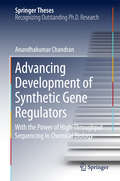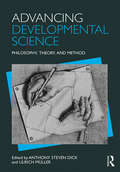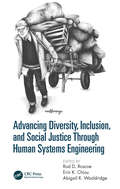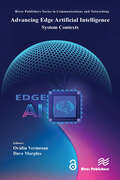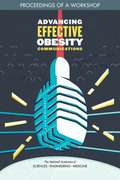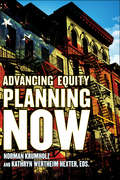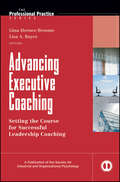- Table View
- List View
Advancing Development of Synthetic Gene Regulators: With the Power of High-Throughput Sequencing in Chemical Biology (Springer Theses)
by Anandhakumar ChandranThis book focuses on an "outside the box" notion by utilizing the powerful applications of next-generation sequencing (NGS) technologies in the interface of chemistry and biology. In personalized medicine, developing small molecules targeting a specific genomic sequence is an attractive goal. N-methylpyrrole (P)-N-methylimidazole (I) polyamides (PIPs) are a class of small molecule that can bind to the DNA minor groove. First, a cost-effective NGS (ion torrent platform)-based Bind-n-Seq was developed to identify the binding specificity of PIP conjugates in a randomized DNA library. Their biological influences rely primarily on selective DNA binding affinity, so it is important to analyze their genome-wide binding preferences. However, it is demanding to enrich specifically the small-molecule-bound DNA without chemical cross-linking or covalent binding in chromatinized genomes. Herein is described a method that was developed using high-throughput sequencing to map the differential binding sites and relative enriched regions of non-cross-linked SAHA-PIPs throughout the complex human genome. SAHA-PIPs binding motifs were identified and the genome-level mapping of SAHA-PIPs-enriched regions provided evidence for the differential activation of the gene network. A method using high-throughput sequencing to map the binding sites and relative enriched regions of alkylating PIP throughout the human genome was also developed. The genome-level mapping of alkylating the PIP-enriched region and the binding sites on the human genome identifies significant genomic targets of breast cancer. It is anticipated that this pioneering low-cost, high through-put investigation at the sequence-specific level will be helpful in understanding the binding specificity of various DNA-binding small molecules, which in turn will be beneficial for the development of small-molecule-based drugs targeting a genome-level sequence.
Advancing Developmental Science: Philosophy, Theory, and Method
by Ulrich Müller Anthony S. DickDevelopmental science is an interdisciplinary scientific field dedicated to describing, understanding, and explaining change in behavior across the lifespan and the psychological, environmental, and biological processes that co-determine this change during the organism’s development. Developmental science is thus a broad discipline that lies at the intersection of psychology, biology, sociology, anthropology and other allied disciplines. Advancing Developmental Science: Philosophy, Theory, and Method reflects this broad view of developmental science, and reviews the philosophical, theoretical, and methodological issues facing the field. It does so within the Process-Relational paradigm, as described by developmentalist Willis Overton over the course of his career. Within that framework, this book explores development in a number of specific cognitive, neurobiological, and social domains, and provides students and researchers with a comprehensive suite of conceptual and methodological tools to describe, explain, and optimize intraindividual change across the lifespan.
Advancing Digital Humanities
by Paul Longley Arthur Katherine BodeAdvancing Digital Humanities moves beyond definition of this dynamic and fast growing field to show how its arguments, analyses, findings and theories are pioneering new directions in the humanities globally.
Advancing Disease Modeling in Animal-Based Research in Support of Precision Medicine: Proceedings Of A Workshop
by Engineering Medicine National Academies of SciencesPrecision medicine is focused on the individual and will require the rapid and accurate identification and prioritization of causative factors of disease. To move forward and accelerate the delivery of the anticipated benefits of precision medicine, developing predictable, reproducible, and reliable animal models will be essential. In order to explore the topic of animal-based research and its relevance to precision medicine, the National Academies of Sciences, Engineering, and Medicine convened a 2-day workshop on October 5 and 6, 2017. The workshop was designed to focus on the development, implementation, and interpretation of model organisms to advance and accelerate the field of precision medicine. Participants examined the extent to which next-generation animal models, designed using patient data and phenotyping platforms targeted to reveal and inform disease mechanisms, will be essential to the successful implementation of precision medicine. This publication summarizes the presentations and discussions from the workshop.
Advancing Diversity in the US Industrial Science and Engineering Workforce: Summary of a Workshop
by Rita S. GuentherThousands of gifted individuals, including women and underrepresented minorities, remain a disproportionally small fraction of those in science, technology, engineering, and math (STEM) careers. Industry, as the largest employer category of those with STEM backgrounds, stands to benefit considerably from greater inclusion of women and underrepresented minorities in the workforce. However, nothing short of a game-changing environment must be created to harness the talent of those not fully represented in the STEM workforce. Advancing Diversity in the US Industrial Science and Engineering Workforce is the summary of a workshop held in May, 2012 by the National Academy of Engineering, focusing on the needs and challenges facing industry in particular, and it is intended to facilitate further discussion and actions to address these complex issues. The workshop provided a forum for leaders from industry, academia, and professional associations to share best practices and innovative approaches to recruiting, retaining, and advancing women and underrepresented minorities in the scientific and engineering workforce throughout the nation's industries.
Advancing Diversity, Equity, Inclusion, and Accessibility in the Leadership of Competed Space Missions
by Space Studies Board Division on Engineering and Physical Sciences Board on Science Education National Academies of Sciences, Engineering, and Medicine Committee on Increasing Diversity and Inclusion in the Leadership of Competed Space MissionsFostering diverse and inclusive teams that are highly skilled, innovative, and productive is critical for maintaining U.S. leadership in space exploration. In recent years, NASA has taken steps to advance diversity, equity, inclusion, and accessibility (DEIA) in their workforce by releasing its equity action plan, emphasizing how diverse and inclusive teams help maximize scientific returns, and requiring DEIA plans as part of announcements of opportunities. To further its efforts to advance DEIA, the Agency requested the National Academies undertake a study to evaluate ways NASA can address the lack of diversity in space mission leadership. Advancing Diversity, Equity, Inclusion, and Accessibility in the Leadership of Competed Space Missions outlines near and long-term actions NASA can take to make opportunities for leadership and involvement in competed space missions more accessible, inclusive, and equitable. Report recommendations range from changes to the mission proposal process to investments in STEM education and career pathways. This report makes 15 recommendations for advancing DEIA within NASA’s Science Mission Directorate divisions that support competed space mission programs. However, many of the report’s recommendations could also be applied broadly to research at NASA and other federal agencies and institutions, leading to a more diverse research workforce.
Advancing Diversity, Inclusion, and Social Justice Through Human Systems Engineering
by Rod D. Roscoe Erin K. Chiou Abigail R. WooldridgeWinner of the "Outstanding Academic Title" recognition by Choice for the 2020 OAT Awards. The Choice OAT Award represents the highest caliber of scholarly titles that have been reviewed by Choice and conveys the extraordinary recognition of the academic community.Advancing Diversity, Inclusion, and Social Justice through Human Systems Engineering highlights how scholars and practitioners of HSE (inclusively defined to span many fields) can apply their theories and methods to understand and support healthy communities, include and empower diverse populations, and inspire strategies for a more inclusive future. This volume brings together experts from human factors, ergonomics, psychology, human-computer interaction, and more to demonstrate how these fields can be applied to societal challenges and solutions. Through a blend of research reports, literature reviews, and personal narratives, this volume explores these issues from the individual to the global scale, across diverse populations, and across multiple continents. Features Draws upon human factors and ergonomics theories and methods to evaluate, understand, and confront systemic threats to inclusion and social justice Offers actionable methodologies, strategies, and recommendations for conducting human-centered research, design, and training with marginalized or vulnerable populations Offers a venue for reporting and reconsidering the work of human factors and ergonomics from the perspectives of diversity, inclusion, and social justice
Advancing East Asian Regionalism (Politics in Asia)
by Nicholas Thomas Melissa G. CurleyDevelopments in East Asia have progressed rapidly in terms of regionalism since the 1997 crisis. The end of the Asian miracle called into question not only the capacity of regional states to meet the needs of their attendant peoples, but also challenged the viability of regional organizations, such as ASEAN, to adapt and respond to the changing circumstances. Advancing East Asian Regionalism looks at the ways in which ASEAN has expanded since the crisis, and evaluates the potential of East Asia to come together in a regional formation - one capable of representing the region as a whole - akin to the European Community. It draws upon the knowledge and perspectives of academics and policy makers actively engaged in the contradictory issues of regionalism. Coupling case study material on regionalism, institutions, and sectoral cooperation, with theoretical debates on regionalization, this book is an invaluable resource that pushes our understanding of East Asian regionalism forward.
Advancing Edge Artificial Intelligence: System Contexts (River Publishers Series in Communications and Networking)
by Ovidiu Vermesan Dave MarplesThe intersection of AI, the Internet of Things (IoT) and edge computing has kindled the edge AI revolution that promises to redefine how we perceive and interact with the physical world through intelligent devices. Edge AI moves intelligence from the network centre to the devices at its edge, entrusting these endpoints to analyse data locally, make decisions, and provide real-time responses.Recent advances in power-efficient high-performance embedded silicon make edge AI a viable proposition, albeit one requiring new distributed architectures and novel design concepts. Moving decision-making closer to the edge makes responses faster and systems more reliable, while the constant pressure to reduce network bandwidth demand and the need to contain spiralling data storage and operations costs help justify the engineering investment necessary to embrace this new paradigm. Moving to decentralised operation opens the door to a multitude of novel applications, covering immersive technologies and autonomous systems across fields as diverse as healthcare and industrial automation, personal assistance and prognostics, surgery, and process control. In the best tradition of systems engineering, the first stage of this transition process is understanding the application domain for edge AI deployment, the ""system context"".This book presents some key topics and early thinking from the EdgeAI* project, covering data backhaul technologies, lifecycle management, mechanisms for developing AIs at the edge and techniques for interacting with those AIs. It provides examples of application domains before concluding with a review of how edge AI systems can be understood by their users. It also examines and presents new results based on current investigations and activities in edge AI technologies, considering the future trends in autonomic systems, hyperautomation, AI engineering, generative AI, connectivity, and cybersecurity mesh.This book aims to empower the reader with the knowledge and insights needed to understand and embrace the transformative power of edge AI technology. The extensively referenced chapters, contributed by experts and thought leaders in the field, are recommended to anyone interested in developing edge AI systems.*Edge AI Technologies for Optimised Performance Embedded Processing" (EdgeAI) Key Digital Technologies (KDT) Joint Undertaking (JU) European research project. https://https://edge-ai-tech.eu/
Advancing Education: School Leadership in Action (Routledge Library Editions: Education Management)
by William Walker Robin Farquhar Meredydd HughesOriginally published in 1991. Compiled by prominent figures in the educational administration field across the Commonwealth for the twentieth anniversary of the foundation of the Commonwealth Council for Educational Administration (CCEA) this imaginative and forward-looking book is for practitioners and academics world-wide. The book illuminates significant issues in educational administration; sensitizes readers to the rapidity and inevitability of change in the field; guides well-informed administrative action; provides a comprehensive overview of emergent developments in the study and practice of educational administration; and demonstrates the leadership of the CCEA as a professional association. Having regard to differences of national context, universal issues of policy and practice are explored and two key leadership roles are described and analysed, namely, that of school principal / head teacher, and that of school superintendent / education officer.
Advancing Educational Equity for Students of Mexican Descent: Creating an Asset-based Bicultural Continuum Model (Routledge Research in Educational Equality and Diversity)
by Andrea Romero Iliana ReyesDrawing on participatory action research conducted with students, parents, families, and school staff in a Southwest community in the United States, this volume contests the interpretation of the achievement gap for students of Mexican descent in the American education system and highlights asset-based approaches that can facilitate students’ academic success. By presenting the Asset-Based Bicultural Continuum Model (ABC) and demonstrating the applications in a variety of family, school, and community-based initiatives, this volume demonstrates how community and cultural wealth can be harnessed to increase educational opportunities for Latino students. The ABC model offers new strategies which capitalize on the bicultural and linguistic assets rooted in local communities and offers place-based strategies driven by communities themselves in order to be tailored to students’ strengths. The text makes a significant contribution to understanding the social ecology of Latinx students’ experiences and offers a new direction for effective and evidence-based academic and health programs across the United States. This book will be a valuable resource for researchers and academics with an interest in the sociology of education, multicultural education, urban education, and bilingual education. It will be of particular interest to those with a focus on Hispanic and Latino studies.
Advancing Effective Obesity Communications: Proceedings of a Workshop
by Engineering Medicine National Academies of SciencesOn September 16, 2019, the Roundtable on Obesity Solutions of the Health and Medicine Division of the National Academies of Sciences, Engineering, and Medicine, held a public workshop, Advancing Effective Obesity Communications, in Washington, DC. The workshop explored effective communication of obesity-related issues by providing an overview of the current communications environment and addressing the complexity of identifying key audiences and developing targeted messages. Speakers discussed communications strategies to reach specific intermediary audiences, such as the public, decision makers, and policy makers. The workshop also explored challenges in communicating about obesity issues, which include aligning the intended meaning of messages with an individual’s perception of and response to those messages, addressing obesity bias and stigma through communications, and addressing misinformation. This publication summarizes the presentations and discussions that occurred at the workshop.
Advancing Empire: English Interests and Overseas Expansion, 1613–1688
by Roper L. H.In Advancing Empire, L. H. Roper explores the origins and early development of English overseas expansion. Roper focuses on the networks of aristocrats, merchants, and colonial-imperialists who worked to control the transport and production of exotic commodities, such as tobacco and sugar, as well as the labor required to produce them. He is primarily interested in the relationship between the English state and the people it governed, the role of that state in imperial development, the socio-political character of English colonies and English relations with Asians, Africans, American Indians, and other Europeans overseas. The activities stimulated the expansion and integration of global territorial and commercial interests that became the British Empire in the eighteenth century. In exploring these activities from a wider perspective, Roper offers a novel conclusion that revises popular analyses of the English Empire and of Anglo-America.
Advancing Energy Policy: Lessons on the integration of Social Sciences and Humanities
by Chris Foulds Rosie RobisonThis open access book advocates for the Social Sciences and Humanities to be more involved in energy policymaking. It forms part of the European platform for energy-related Social Sciences and Humanities’ activities, and works on the premise that crossing disciplines is essential. All of its contributions are highly interdisciplinary, with each chapter grounded in at least three different Social Sciences and Humanities disciplines. These varying perspectives come together to cover an array of issues relevant to the energy transition, including: energy poverty, justice, political ecology, governance, behaviours, imaginaries, systems approaches, modelling, as well as the particular challenges faced by interdisciplinary work. As a whole, the book presents new ideas for future energy policy, particularly at the European level. It is a valuable resource for energy researchers interested in interdisciplinary and society-relevant perspectives. Those working outside the Social Sciences and Humanities will find this book an accessible way of learning more about how these subjects can constructively contribute to energy policy.
Advancing Engineering Education Beyond COVID: A Guide for Educators
by Ivan Gratchev Hugo G. EspinosaEducators, are you ready to meet the challenge of cultivating the next generation of engineers in a post-COVID-19 context? Current engineering student cohorts are unique to their predecessors: they are more diverse and have experienced unprecedented disruption to their education due to the COVID-19 pandemic. They will also play a more significant role in contributing to global sustainability efforts. Innovating engineering education is of vital importance for preparing students to confront society’s most significant sustainability issues: our future depends on it. Advancing Engineering Education Beyond COVID: A Guide for Educators offers invaluable insights on topics such as implementing active-learning activities in hybrid modes; developing effective and engaging online resources; creating psychologically safe learning environments that support academic achievement and mental health; and embedding sustainability within engineering education. Students’ own perspectives of online learning are also incorporated, with the inclusion of a chapter authored by undergraduate engineering students. This book consolidates the expertise of leading authorities within engineering education, providing an essential resource for educators responsible for shaping the next generation of engineers in a post-COVID-19 world.
Advancing Entrepreneurship Education in Universities: Concepts and Practices for Teaching and Support
by Robert James CrammondIn the context of the changing nature of universities, this book discusses the progression of enterprise and entrepreneurship education, and conceptualises ‘best practice’ with the aim of enhancing teaching and support for entrepreneurs. Including an overview of entrepreneurship, teaching entrepreneurship, enterprising universities and industrial ecosystems, the author also discusses stakeholder theory and analysis, concluding with a perspective on effective and enterprising learning spaces. An insightful read for researchers, educators and policy-makers, this comprehensive overview provides up-to-date literature and case studies to describe the need for entrepreneurship education, its growth, the influence of key institutional stakeholders, and the future of programme delivery and assessment.
Advancing Entrepreneurship in the United Arab Emirates: Start-up Challenges And Opportunities
by Wasif A. MinhasExplores the role of the entrepreneurs within the economic theory frameworks and types of contribution they make.<P><P> Delves deep into social structures and relationships that heavily influence Emirati behaviour and uncovers how these constructs affect entrepreneurship in the region.<P> Highlights contrasting notions of how entrepreneurship can or should be supported and compares these notions with how entrepreneurship is being supported within the UAE.<P> Discusses the potential and role of accelerators and incubators in advancing entrepreneurship.<P> Reflecting increasing investment in entrepreneurship in the United Arab Emirates (UAE), this new book offers extensive coverage of the factors that enable Emiratis to start and grow a business. Exploring the challenges faced by local start-ups, this book provides insight into the way that entrepreneurship is both perceived and governed in the UAE and how this differs to other countries. The author builds on rich empirical research to propose a model of entrepreneurship which is specific to the UAE, taking into account the role of culture, family and government support. This innovative book underlines the importance of human behaviour in creating successful Emirati start-ups and business opportunities.
Advancing Environmental Education Practice (Cornell Series in Environmental Education)
by Marianne E. KrasnyIn this important intervention, change-agent Marianne E. Krasny challenges the knowledge-attitudes-behavior pathway that underpins much of environmental education practice; i.e., the assumption that environmental knowledge and attitudes lead to environmental behaviors. Krasny shows that certain types of knowledge are more likely than others to influence behaviors, and that generally it is more effective to work with existing attitudes than to try to change them. The chapters expand the purview of potential outcomes of environmental education beyond knowledge and attitudes to include nature connectedness, sense of place, efficacy, identity, norms, social capital, youth assets, and individual wellbeing.Advancing Environmental Education Practice also shows how, by constructing theories of change for their environmental education programs, environmental educators can target specific intermediate outcomes likely to lead to environmental behaviors and collective action, and plan activities to achieve those intermediate outcomes. In some cases, directly engaging program participants in the desired behavior or collective action can lead to changes in efficacy, sense of place, and other intermediate outcomes, which in turn foster future environmental actions. Finally, Advancing Environmental Education Practice shares twenty-four surveys that assess changes in environmental behaviors and intermediate outcomes, and provides guidelines for qualitative evaluations.Thanks to generous funding from the Cornell Department of Natural Resources, the ebook editions of this book are available as Open Access volumes from Cornell Open (cornellopen.org) and other Open Access repositories.
Advancing Environmental Justice for Marginalized Communities in India: Progress, Challenges and Opportunities
by Aruna Kumar Malik Alan P. Diduck Kirit PatelThis interdisciplinary collection examines social equity and environmental justice in India. It assesses the effectiveness of environmental policies and institutions in rendering justice for marginalized communities while ensuring protection of the environment. It also analyses the influence of the neoliberal state and its political economies on the development and outcomes of these policies and institutions. The book provides a unique perspective on environmental justice because of its consistent emphasis on social justice, rather than the prevailing predominant analyses from legal or environmental perspectives. It explores the themes of effectiveness and equity as they pertain to public policy instruments, such as environmental impact assessment, environmental licensing and enforcement, public hearings, and environmental activism strategies. The four interlinked dimensions of environmental justice, namely recognitional justice, procedural justice, distributive justice, and restorative justice, provide the core of the book’s conceptual framework. The contributions draw on ideas and methods from development studies, environmental geography, environmental law and policy, natural resource management, public administration, and political economy The book concludes by considering planning, policy and institutional reforms and community-based initiatives that are needed to promote and protect environmental justice in India. Offering an important reference for researchers and scholars, this book will appeal to those in law, geography, environmental studies, natural resource management, development studies, sociology, and political science. It will also be of interest to community-based researchers, environmentalists and other civil society activists, natural resource managers, and policy makers.
Advancing Equality: How Constitutional Rights Can Make a Difference Worldwide
by Jody Heymann Aleta Sprague Amy RaubIn a world where basic human rights are under attack and discrimination is widespread, Advancing Equality reminds us of the critical role of constitutions in creating and protecting equal rights. Combining a comparative analysis of equal rights in the constitutions of all 193 United Nations member countries with inspiring stories of activism and powerful court cases from around the globe, the book traces the trends in constitution drafting over the past half century and examines how stronger protections against discrimination have transformed lives. Looking at equal rights across gender, race and ethnicity, religion, sexual orientation and gender identity, disability, social class, and migration status, the authors uncover which groups are increasingly guaranteed equal rights in constitutions, whether or not these rights on paper have been translated into practice, and which nations lag behind. Serving as a comprehensive call to action for anyone who cares about their country’s future, Advancing Equality challenges us to remember how far we all still must go for equal rights for all.
Advancing Equity Planning Now
by Edited by Norman Krumholz and Kathryn Wertheim HexterWhat can planners do to restore equity to their craft? Drawing upon the perspectives of a diverse group of planning experts, Advancing Equity Planning Now places the concepts of fairness and equal access squarely in the center of planning research and practice. Editors Norman Krumholz and Kathryn Wertheim Hexter provide essential resources for city leaders and planners, as well as for students and others, interested in shaping the built environment for a more just world.Advancing Equity Planning Now remind us that equity has always been an integral consideration in the planning profession. The historic roots of that ethical commitment go back more than a century. Yet a trend of growing inequality in America, as well as other recent socio-economic changes that divide the wealthiest from the middle and working classes, challenge the notion that a rising economic tide lifts all boats. When planning becomes mere place-making for elites, urban and regional planners need to return to the fundamentals of their profession. Although they have not always done so, planners are well-positioned to advocate for greater equity in public policies that address the multiple objectives of urban planning including housing, transportation, economic development, and the removal of noxious land uses in neighborhoods.Thanks to generous funding from Cleveland State University, the ebook editions of this book are available as Open Access volumes from Cornell Open (cornellopen.org) and other repositories.
Advancing Equity and Achievement in America's Diverse Schools: Inclusive Theories, Policies, and Practices
by Sonya Douglass Horsford Camille M. WilsonAdvancing Equity and Achievement in America’s Diverse Schools illustrates how educators, students, families and community partners can work in strategic ways to build on social, cultural, and ethnic diversity to advance educational equity and achievement. By drawing on the latest data on demographic change, constructions of culture and cultural difference, and the politics of school reform in urban, rural, and suburban school communities, this volume looks toward solutions and strategies for meaningful educational improvement. Contributors consider both the diversity of youth and families served in public schools, and the culture of U.S. schooling, highlighting the influence of policy and reform agendas; students’ identities and agency; experiences and approaches of diverse educators; and the workings of effective school partnerships. Chapters also focus on those often overlooked in educational scholarship such as Native Americans, students experiencing poverty and/or homelessness, Muslim students, students with special needs, and students and educators who are lesbian, gay, bisexual, transgender, intersex, or queer. In all, this edited collection stresses the need for high quality education that is inclusive, culturally responsive and unifying so all students can experience academic success. This book is a meaningful resource for educators, policymakers, and community-based leaders interested in doing such transformative work.
Advancing Equity-Focused School Counseling for All Students: Confronting Disproportionality Across PreK-12 Schools
by Sam Steen Shekila Melchior Amber Brenae Sansbury-ScottUsing author narratives, this book brings attention to racial disparities that currently exist in schools within the historical context of pivotal legal cases in America while emphasizing the importance of assessing and supporting students through a culturally appropriate lens that recognizes student strengths. The authors provide current and historical frameworks through which school counselors can develop a more socially just and liberation-orientated school counseling program. These frameworks center and unveil the ways in which social rank, segregation, and racism influence development, particularly for Black and Brown children. The book underscores the value of community partnerships and the role of strategic partnerships to support a college culture, particularly for student populations with historically limited access to higher education. Readers will also learn about misconceptions of racially and ethnically minoritized children and the related impacts on misdiagnosis and overrepresentation in special education. School counselors looking to ensure equity and social justice within their classrooms, analyze their own privilege, and support students of all backgrounds will find this timely text indispensable in creating a program that fosters understanding and growth.
Advancing Ethnography in Corporate Environments: Challenges and Emerging Opportunities
by Brigitte JordanIn this innovative volume, twelve leading scholars from corporate research labs and independent consultancies tackle the most fundamental and contentious issues in corporate ethnography. Organized in pairs of chapters in which two experts consider different sides of an important topic, these provocative encounters go beyond stale rehearsals of method and theory to explore the entanglements that practitioners wrestle with on a daily basis. The discussions are situated within the broader universe of ethnographic method and theory, as well as grounded in the practical realities of using ethnography to solve problems in the business world. The book represents important advances in the field and is ideal for students and scholars as well as for corporate practitioners and decision makers.
Advancing Executive Coaching
by Gina Hernez-Broome Lisa A. BoyceFor anyone who coaches leaders, this book addresses the most critical issues impacting the future of leadership coaching as an organizational development initiative. It is organized around a Leadership Coaching Framework that employs a systems approach to frame the myriad issues. In addition to the introductory chapter that provides an overview of the book, the sixteen contributed chapters are grouped into three sections with the final chapter providing a review of the major themes in the volume with a discussion integrating the global discussions and future directions for leadership coaching.
